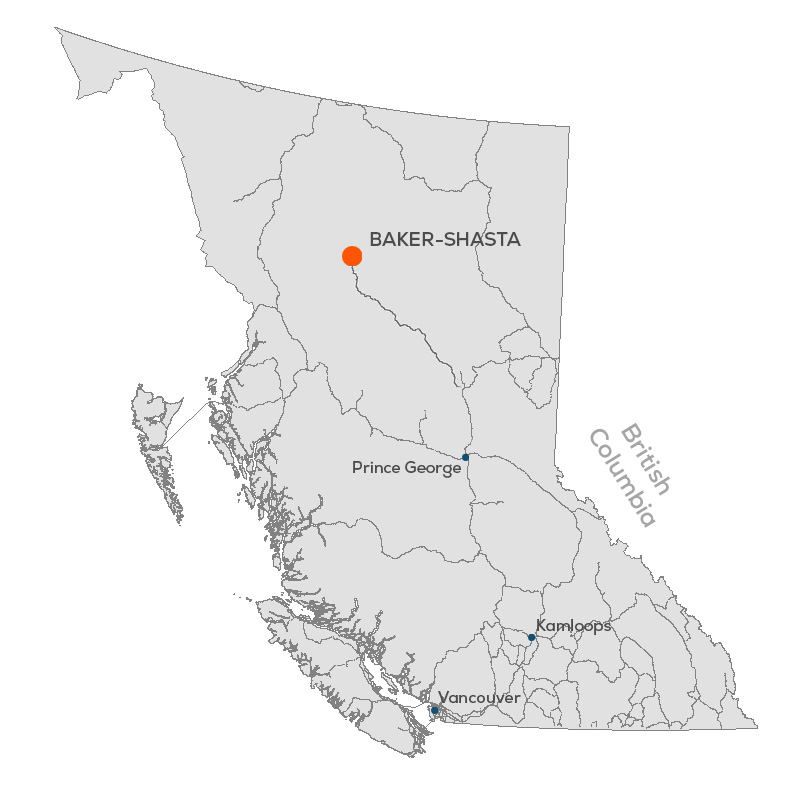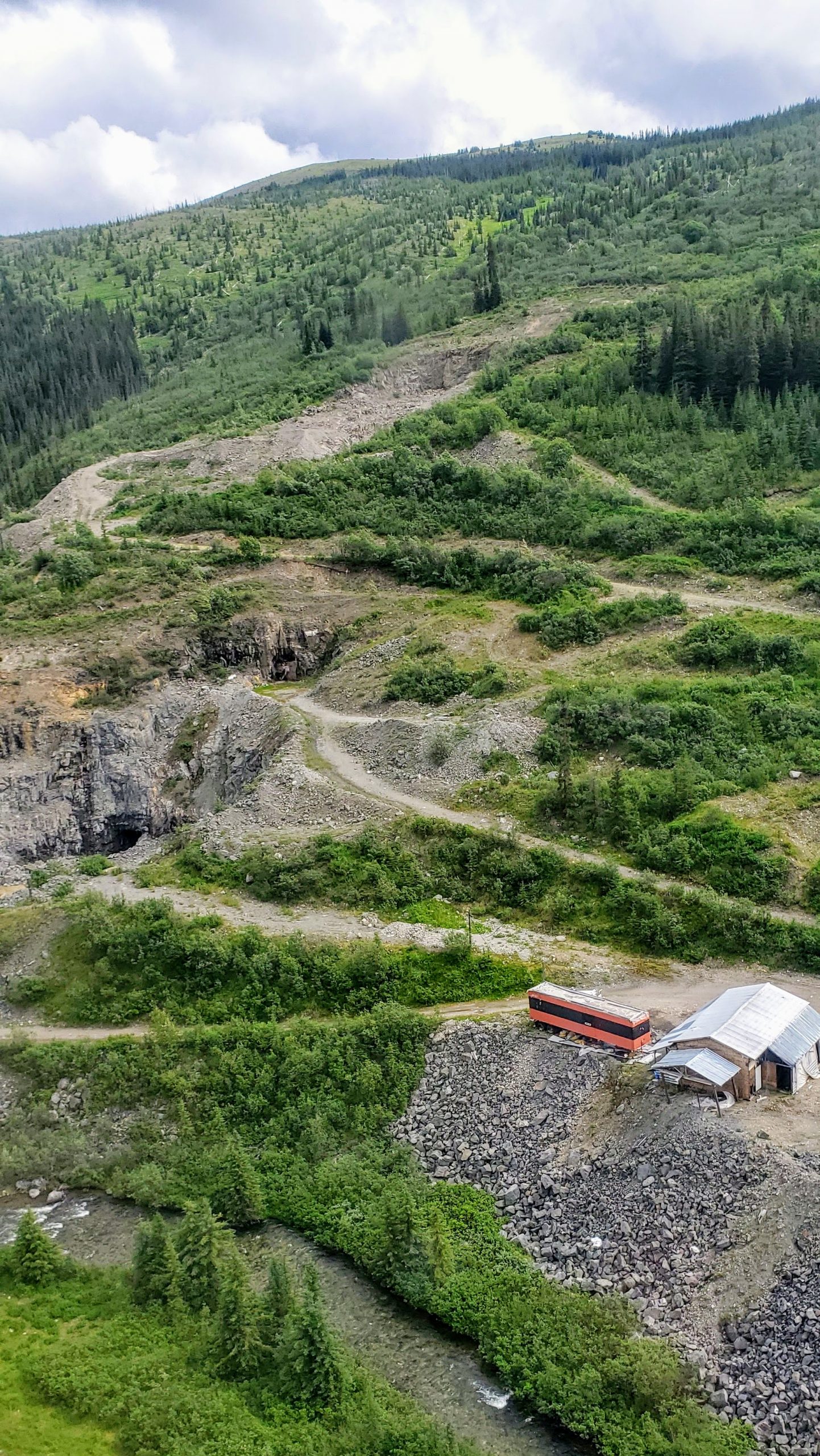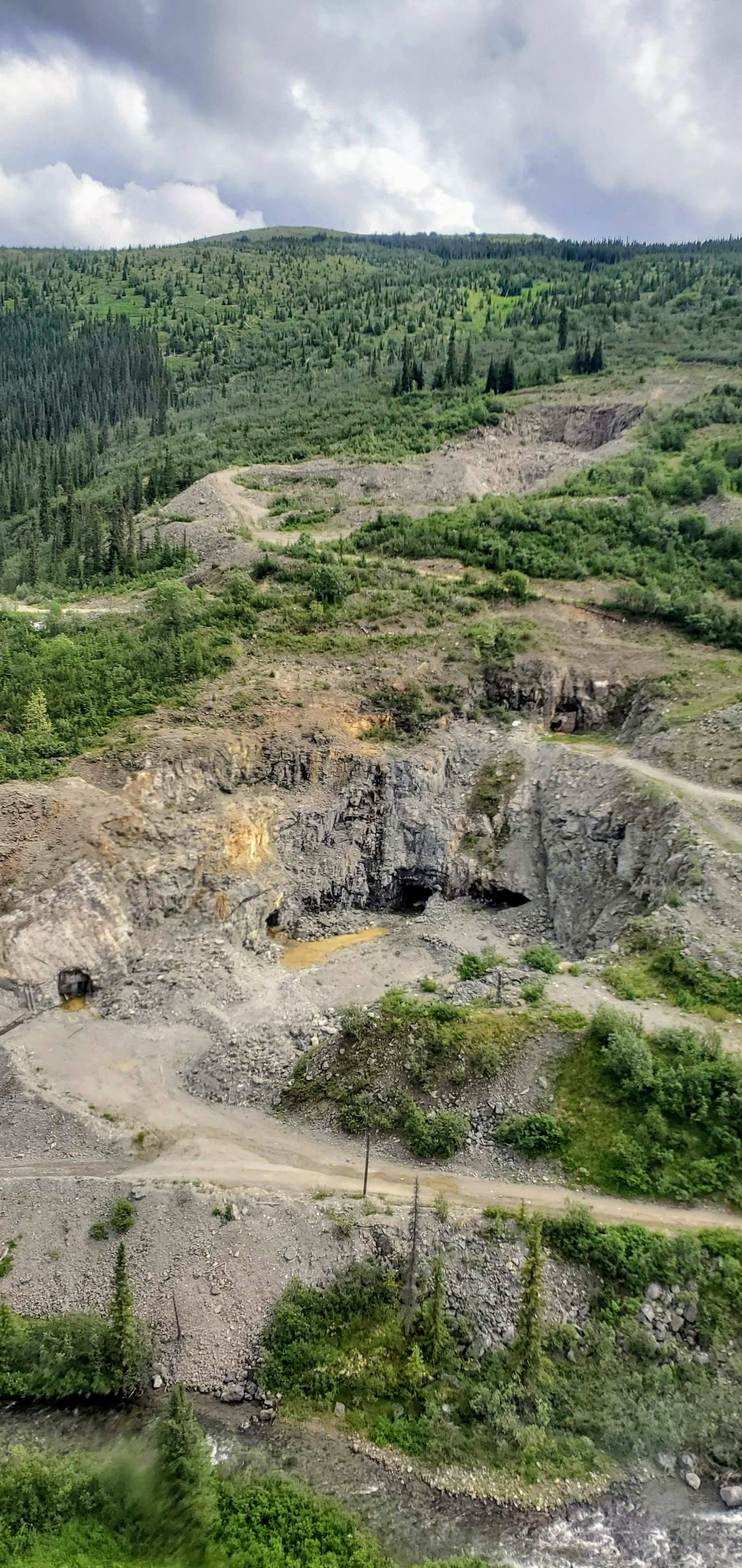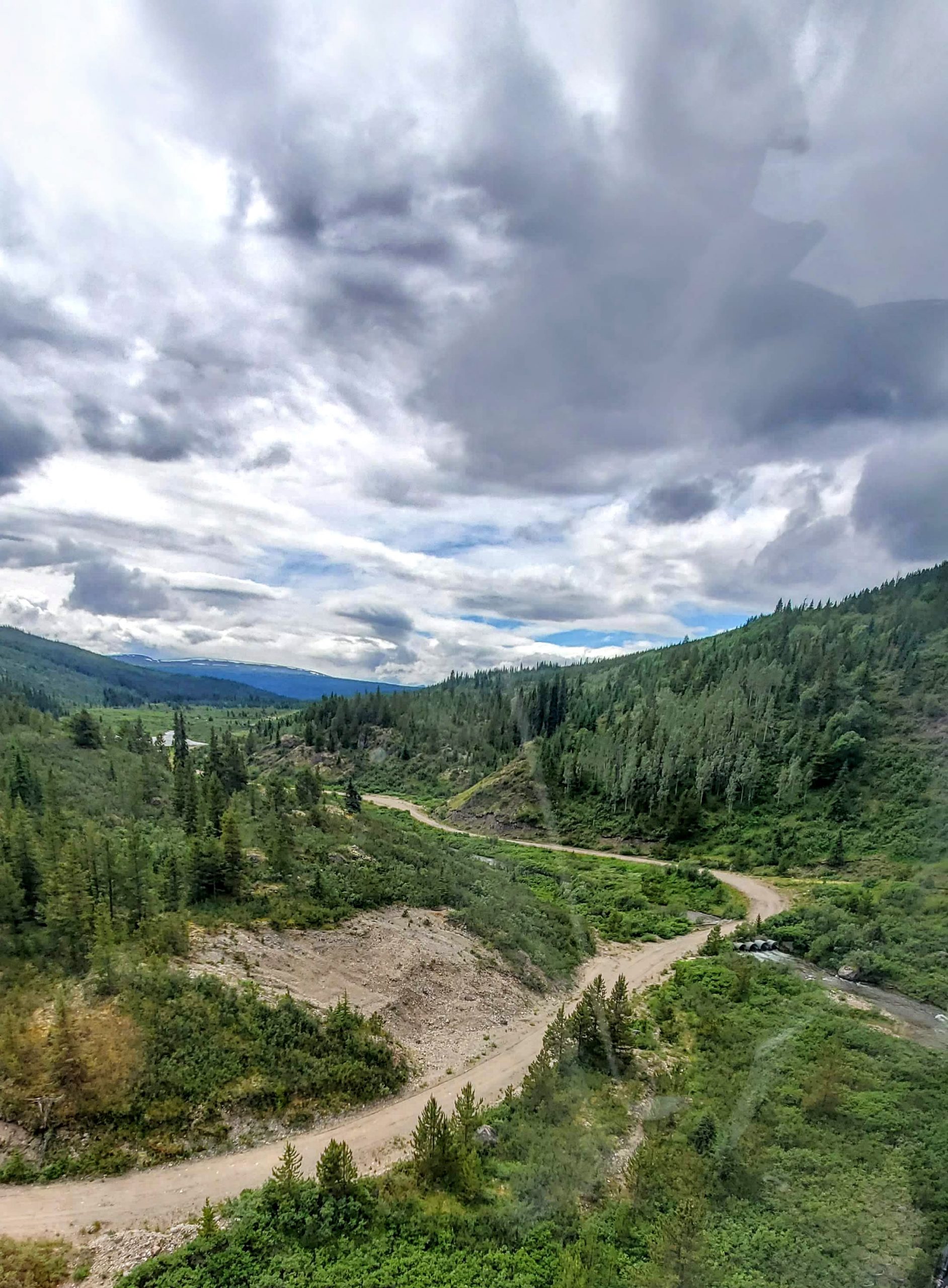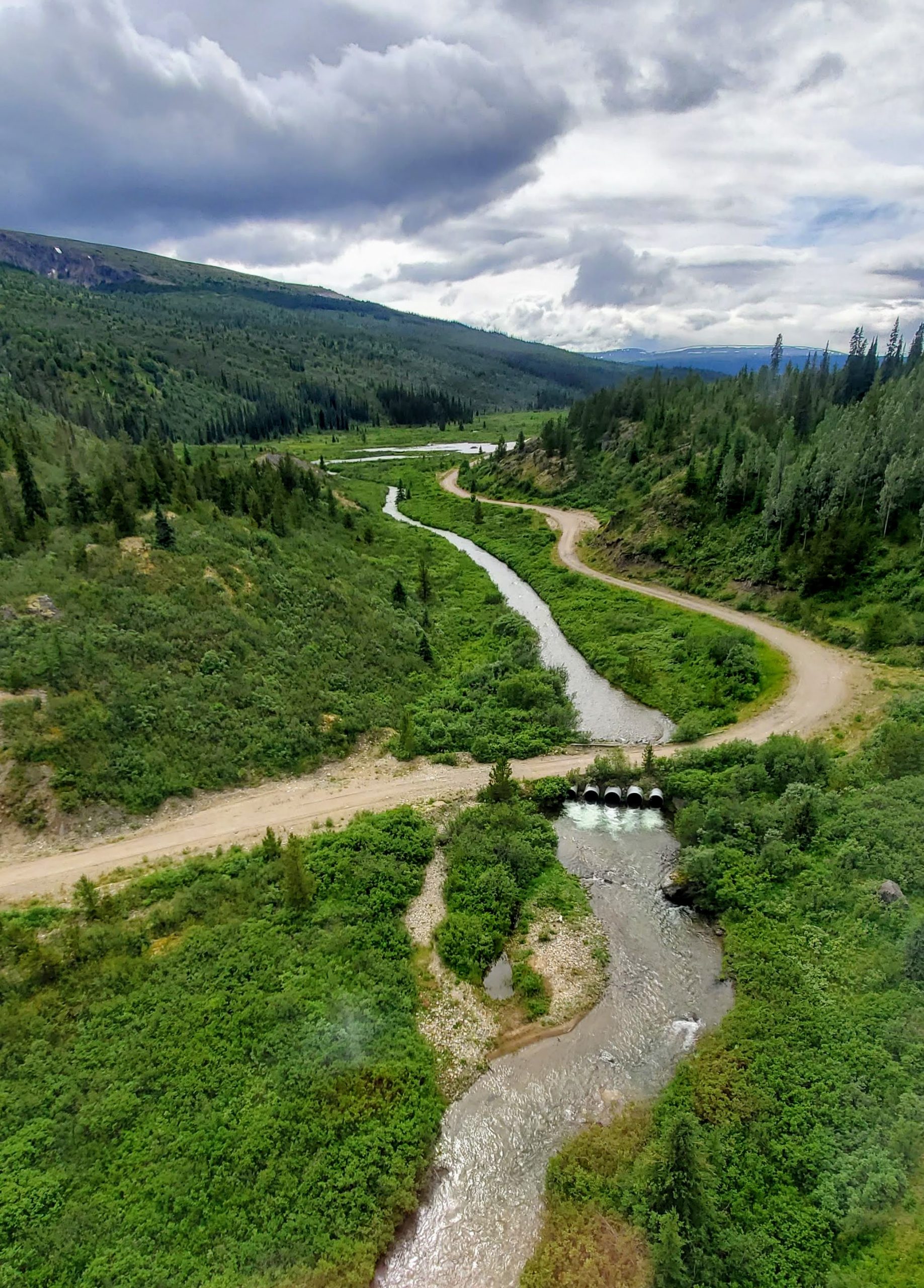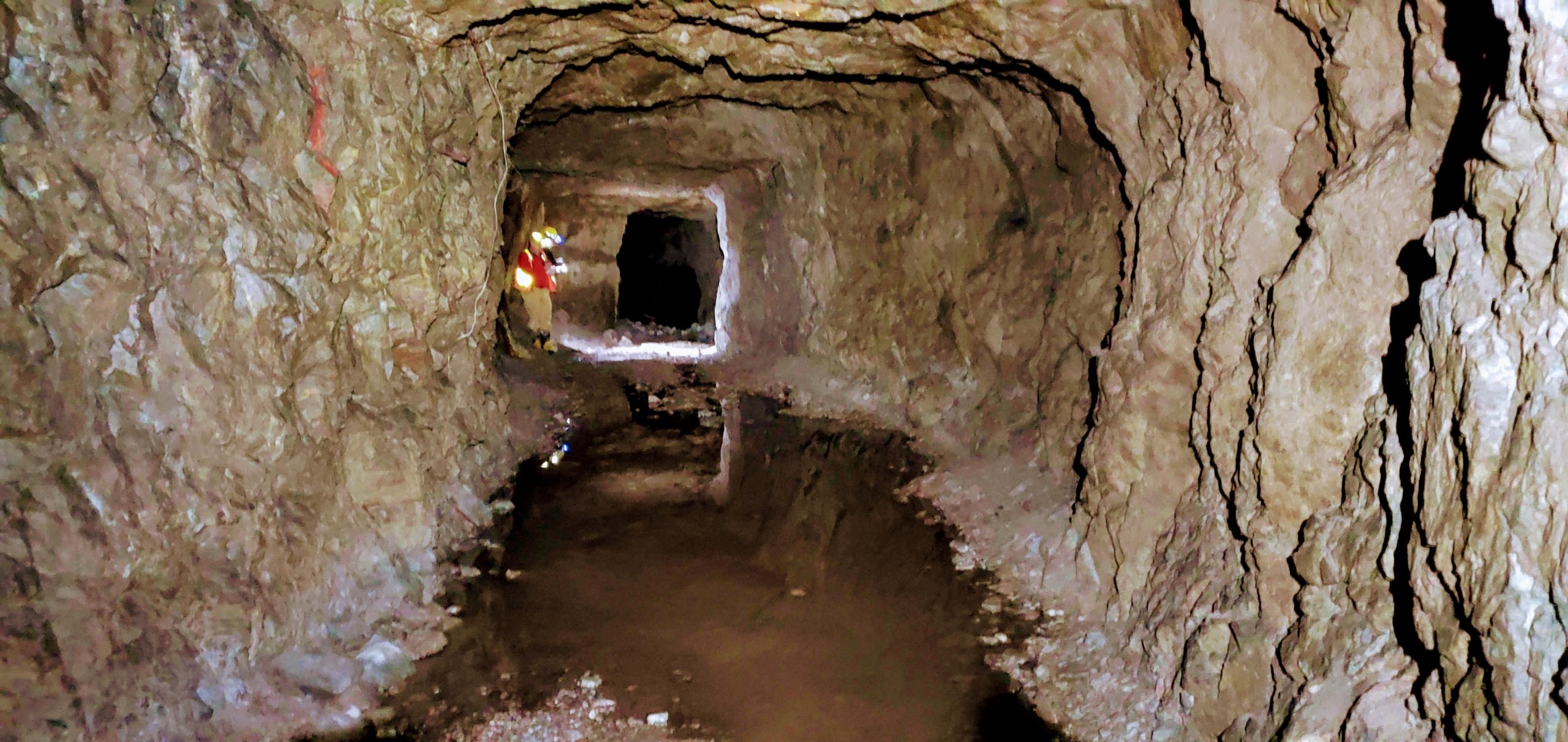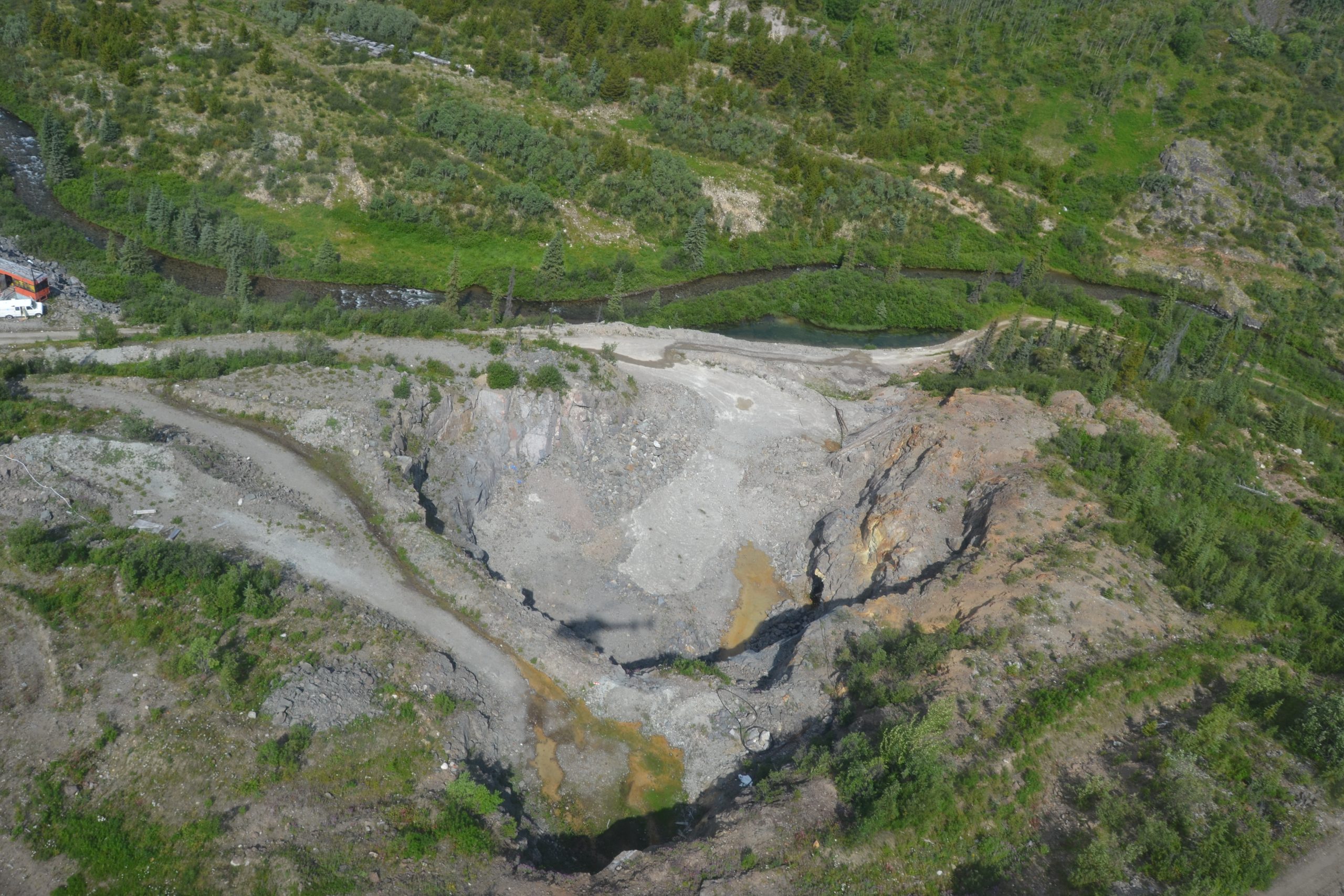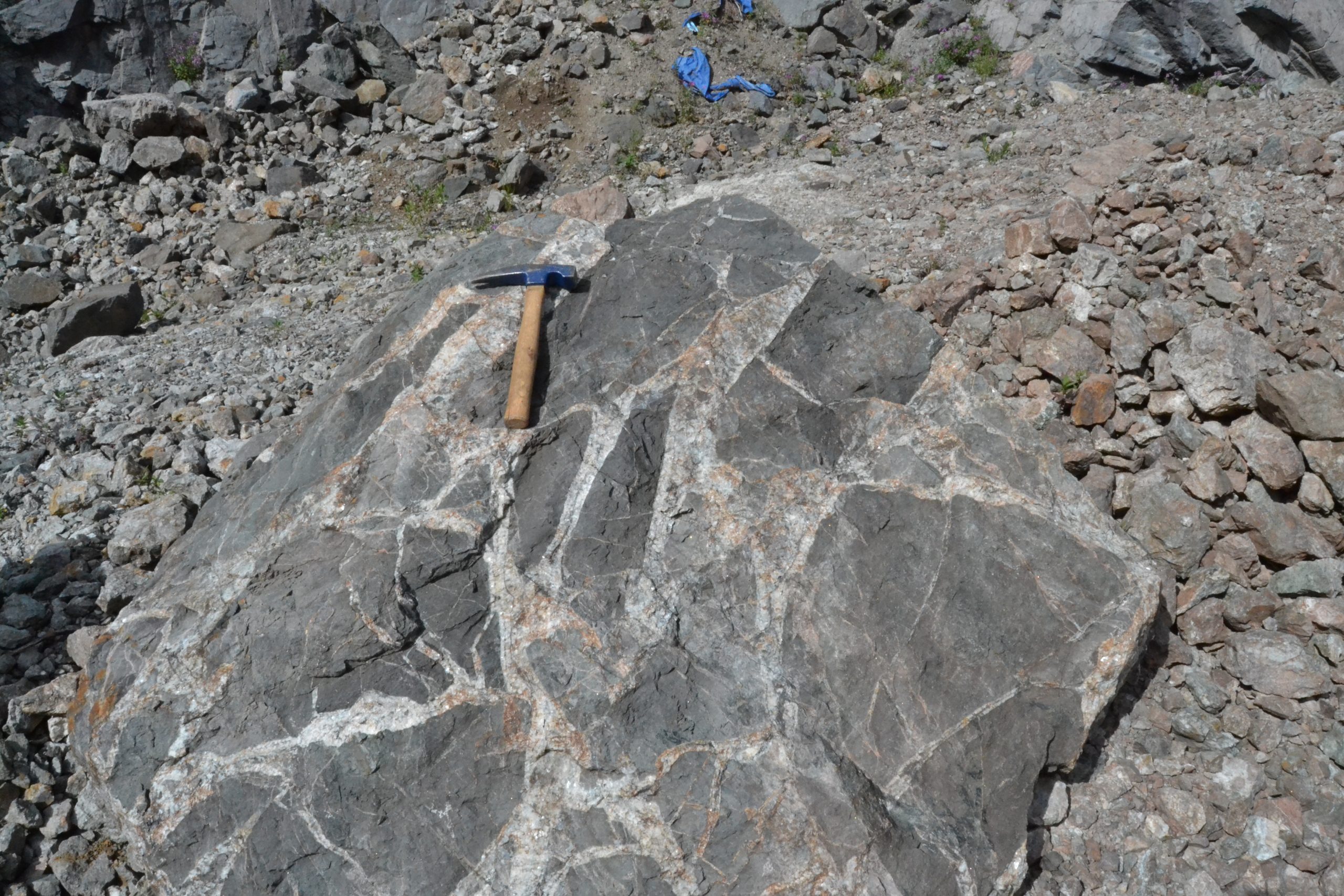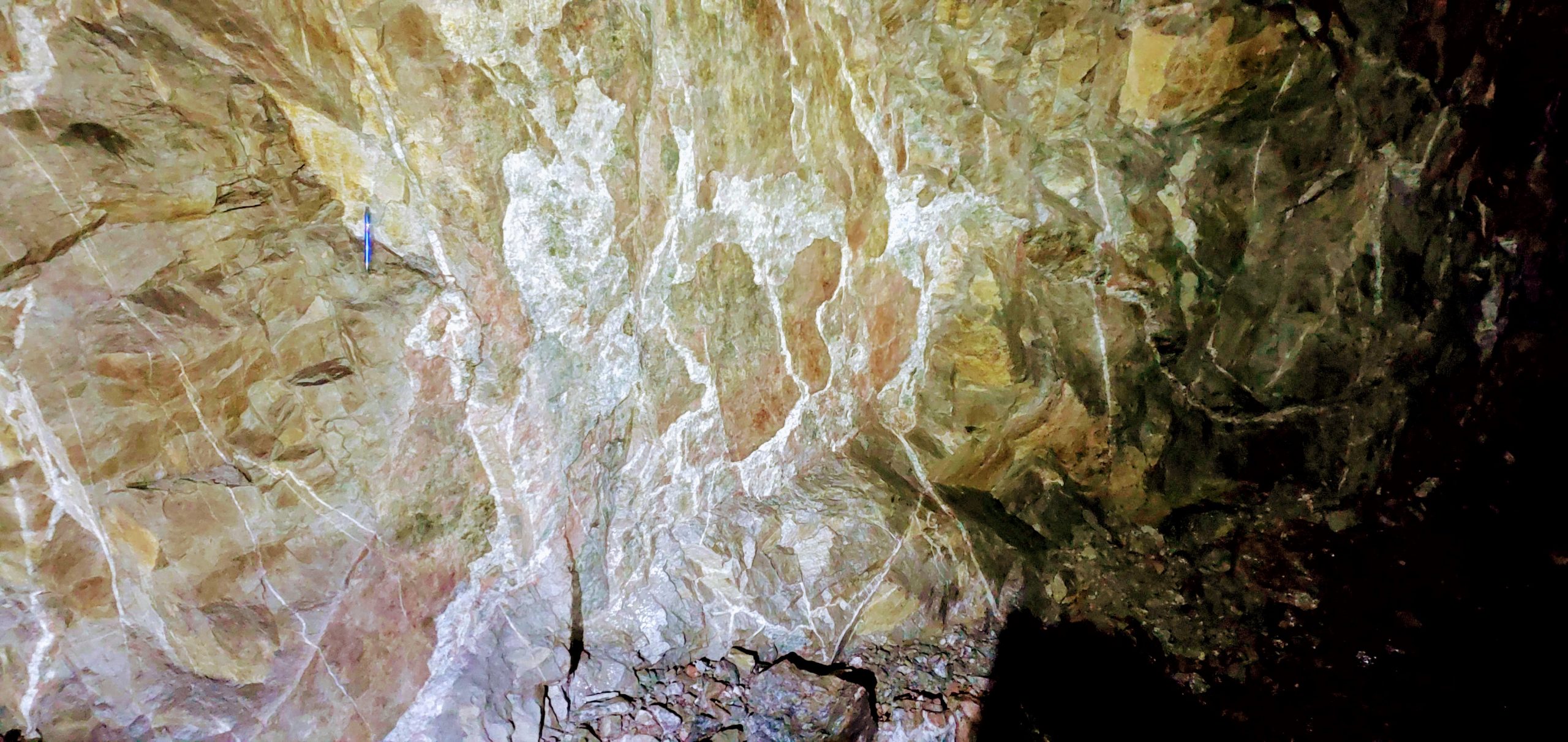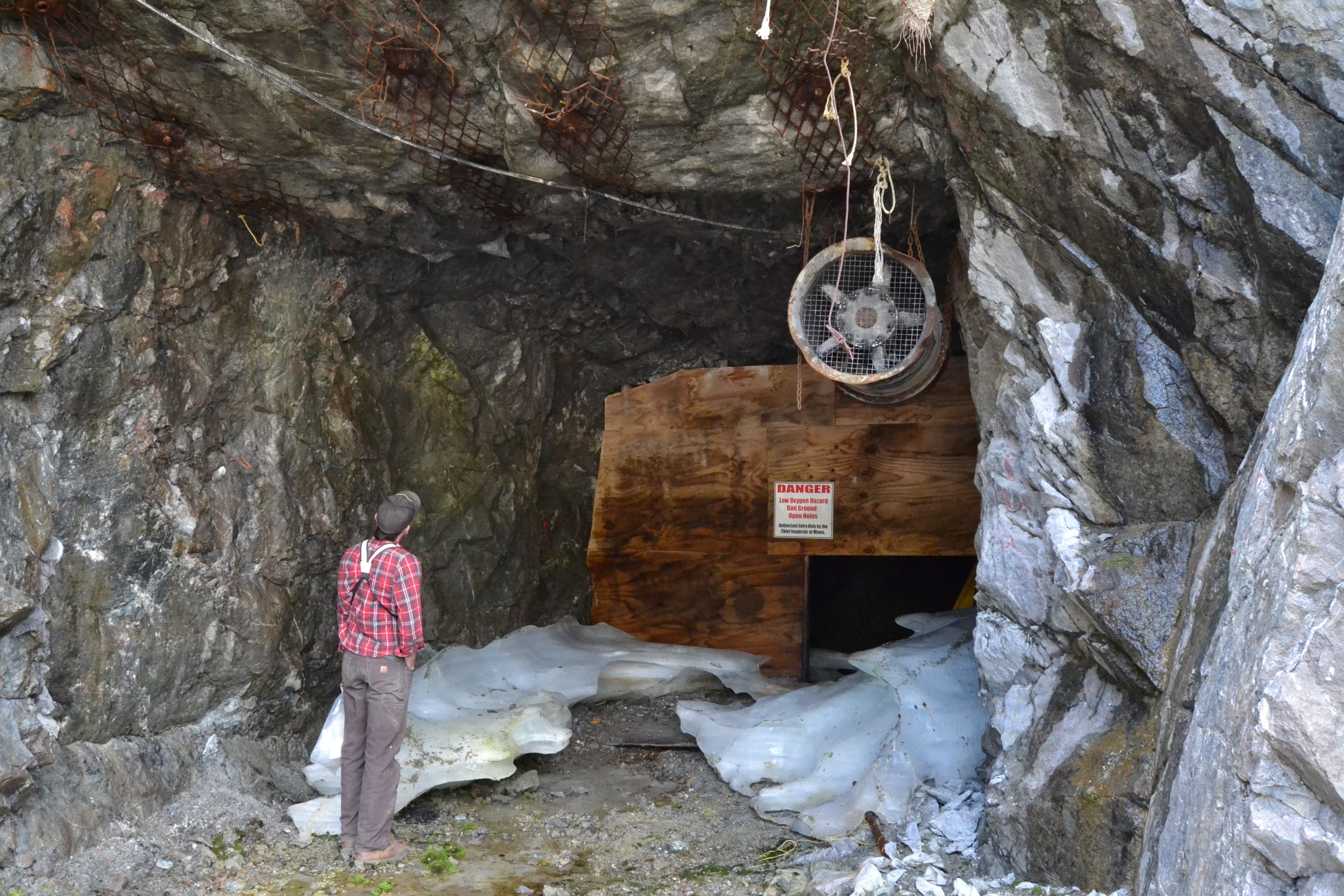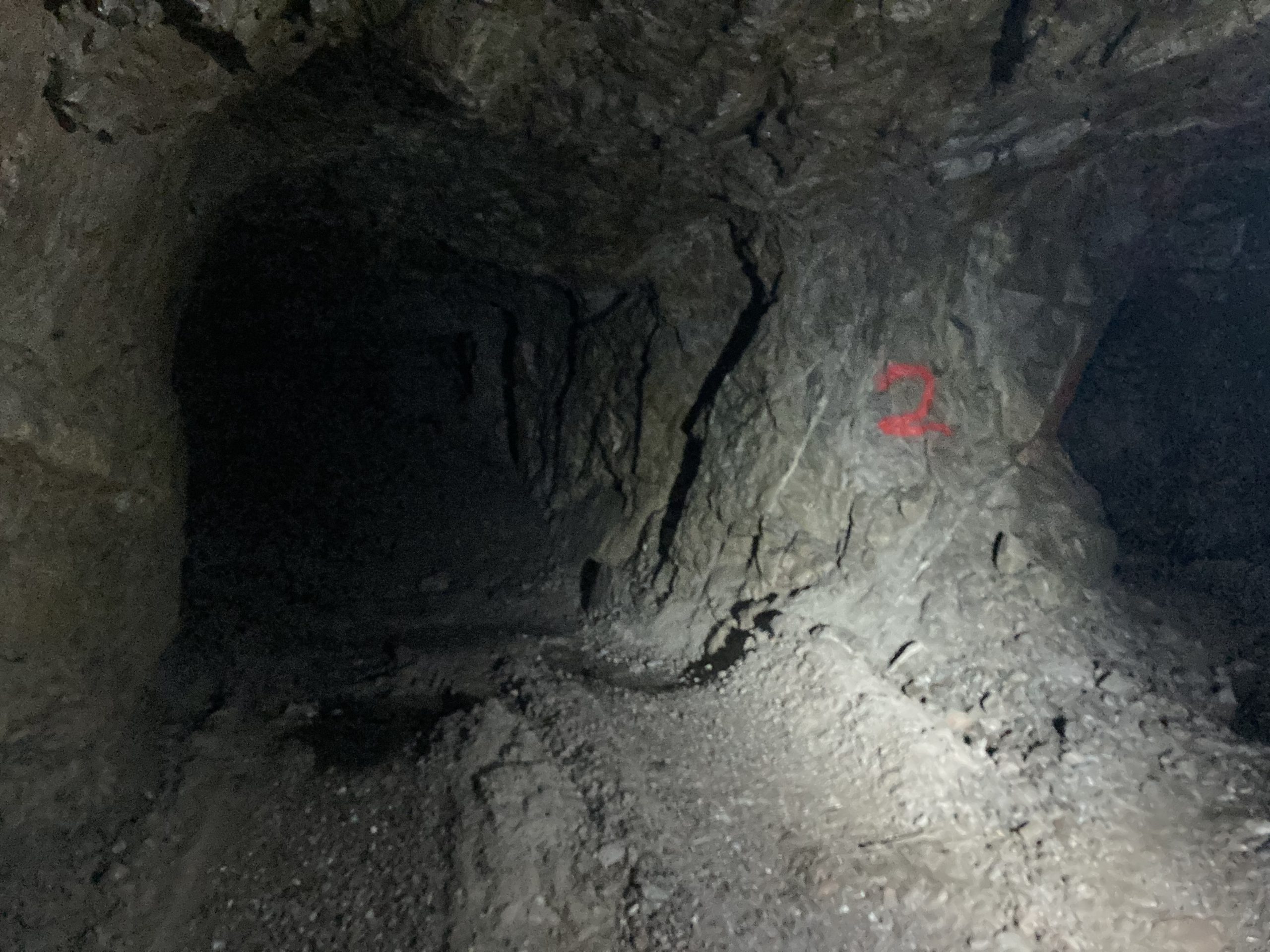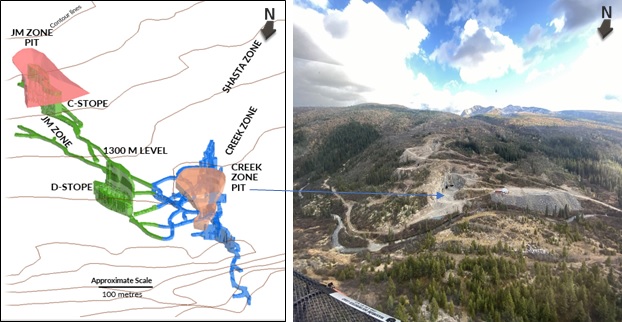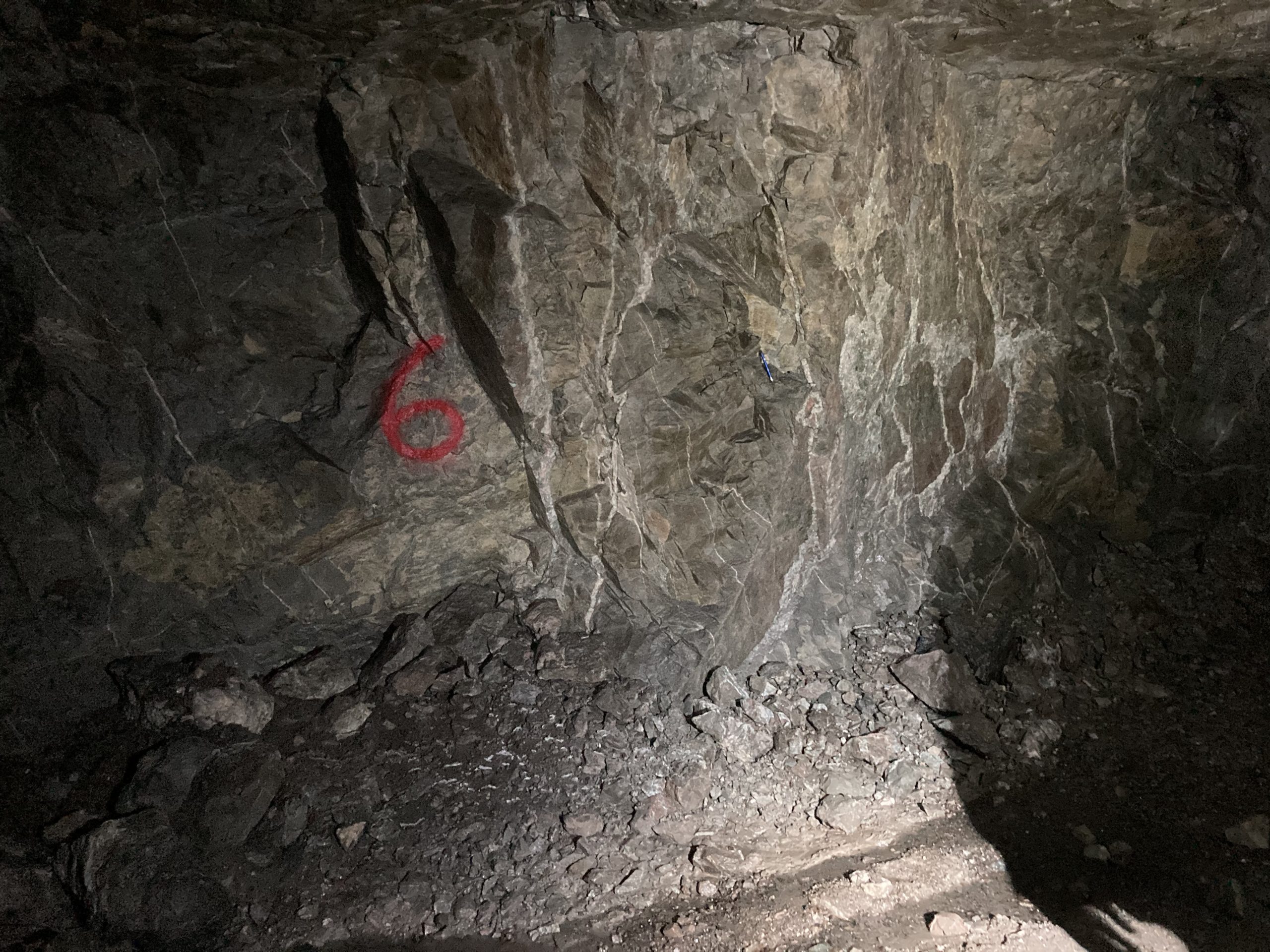Shasta Mine & Deposit
Overview
On January 8th, 2025 TDG published (here) an updated Mineral Resource Estimate (“MRE”) for Shasta & Tailings showing improvements to grade, quantity and confidence when compared to TDG’s Updated MRE published in May 2023. The updated Shasta & Tailings MRE is based on a combination of historical drilling and the two Phases of drilling completed by TDG at Shasta in 2021 & 2022.
TDG completed the acquisition of the Toodoggone asset portfolio of Talisker Resources Ltd. – including the former producing high grade gold-silver Baker and Shasta Mines – in December 2020.
The mines are accessible by road 430 km northwest of Prince George, via Mackenzie and the Omineca Resource access route past Centerra Gold Inc.’s Kemess Copper Gold Mine.
The Baker-Shasta property covers just over 6,000 hectares and includes the former producing high grade gold-silver Baker Mine and Shasta Mine which operated intermittently from the 1980s until 2012 when a lack of funding caused operations to cease.
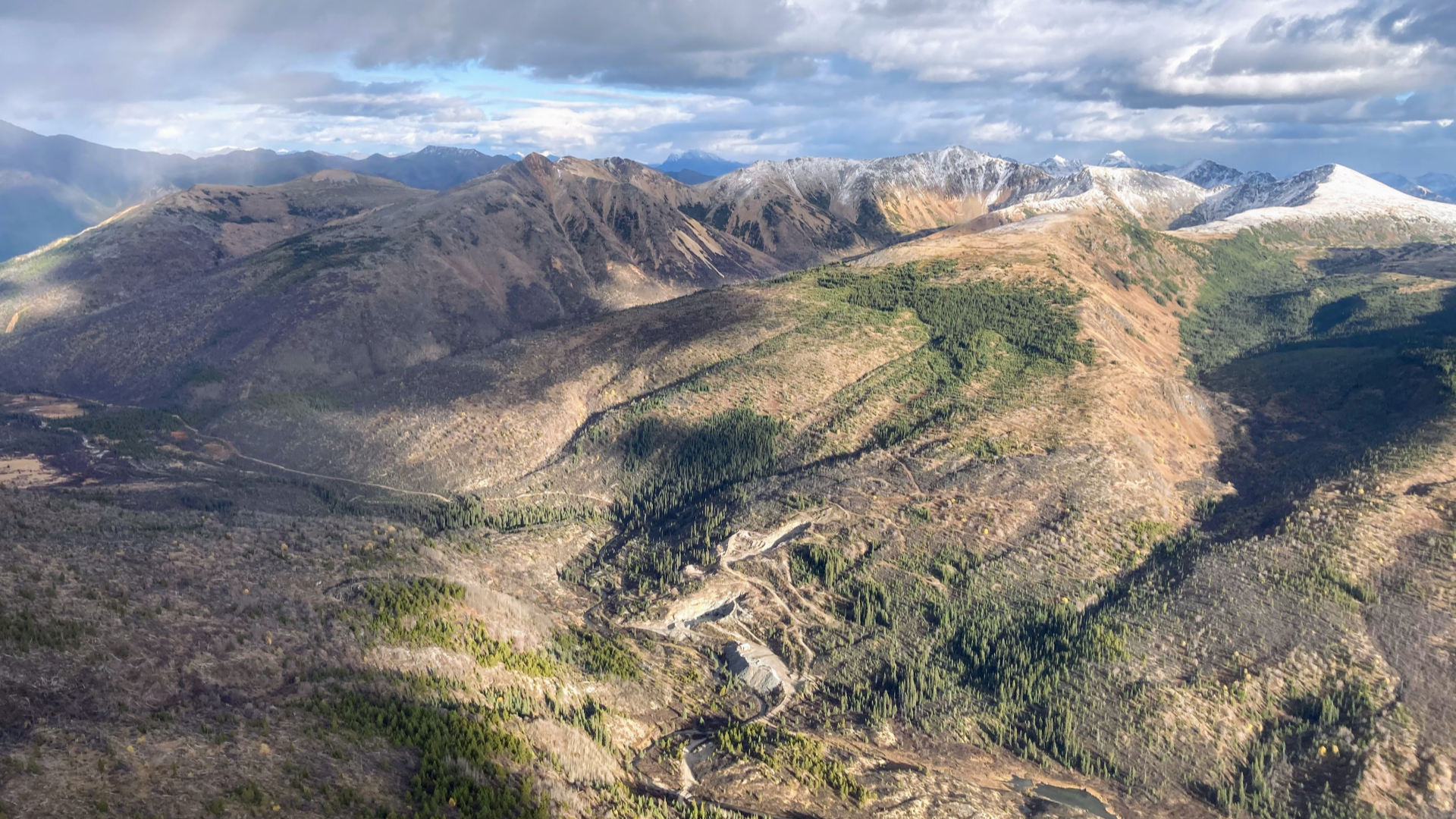
In 2020, TDG undertook recompilation of the historical exploration and production data derived from multiple sources. In total, over 28,000 metres of historical drilling was recompiled and a 3D model was built of the historical small-scale extraction that took place at Shasta. This information helped determine the drill targets for TDG’s first phase of drilling at Shasta which took place from August to November 2021. TDG drilled just over 8,000 metres of oriented HQ core in the first phase of diamond drilling. The results from the drilling were published from January to April 2022.
TDG plans to begin the second phase of diamond drilling at Shasta in July 2022. The second phase will focus on stepping northwards from the higher grade gold-silver intercepted in the Cayley-Rainier Zone to “join it up” with the 2021 drilling undertaking in the vicinity of the historical workings in the Shasta Creek and JM Zones.
Updated NI 43-101 Mineral Resource Estimate
In January 2025, TDG published an updated Mineral Resource Estimate (“MRE”) for Shasta based on Phase 1 & 2 drilling undertaken by TDG in 2021 & 2022 along with information from a portion of the historical drillholes completed at Shasta.
Calculation of the MRE was undertaken by Moose Mountain Technical Services, an independent resource modelling and engineering firm.
Notes
1. The Mineral Resource estimate has been prepared by Sue Bird, P.Eng., an independent Qualified Person. The effective date of the mineral resource estimate is December 29, 2024.
2. Mineral Resources are reported using the 2014 CIM Definition Standards and were estimated in accordance with the CIM 2019 Best Practices Guidelines, as required by NI43-101.
3. Mineral Resources that are not Mineral Reserves do not have demonstrated economic viability. There is no certainty that all Mineral Resources will be converted into Mineral Reserves.
4. The Mineral Resource has been confined by a “reasonable prospects of eventual economic extraction” pit using the following assumptions, which were estimated from comparable projects:
a. Au price of US$2,250/oz, Ag price of US$25/oz at an exchange rate of 0.74 US$ per CDN$;
b. a 1.5 % NSR royalty;
c. 93 % metallurgical recovery for Au, based on past TDG test work, historical mill records4 and nearby project comparables6;
d. 86 % recovery for Ag based on nearby project comparables6 and, while prior MREs assumed somewhat lower Ag recoveries based on historical mill records4 and limited past TDG test work , test work was not optimized for Ag recoveries. Further, test work at comparable projects indicate that improvement could be expected ;
e. 99.9 % payable Au; 95.0 % payable Ag; US$7.00/oz Au and US$3.00/oz Ag offsite costs (refining, transport and insurance);
f. Mining costs of CDN$4.00/tonne mineralized material;
g. Processing Costs of CDN$15/tonne and G&A of CDN$8.00/tonne processed;
h. Pit slopes of 45 degrees.
5. The resulting NSR equation is: NSR (CDN$) = 95.79*Au Grade*0.93 + 0.92*Ag Grade*0.86
6. The resulting AuEq equation is: AuEq = Au + Ag*0.00887
7. The bulk density of the deposit is based on 2021 & 2022 measurements and is assumed to be 2.61 throughout the deposit and 2.00 for overburden.
8. Numbers may not sum due to rounding.
Resource Modelling
- MRE contains 367 DDH (23,963 m assaying)
- Implicit model using 5 metre x 5 metre x 5 metre selective mining unit, interpolated by ID3
- Assumed pit wall slopes 45º, previous workings removed from the resource
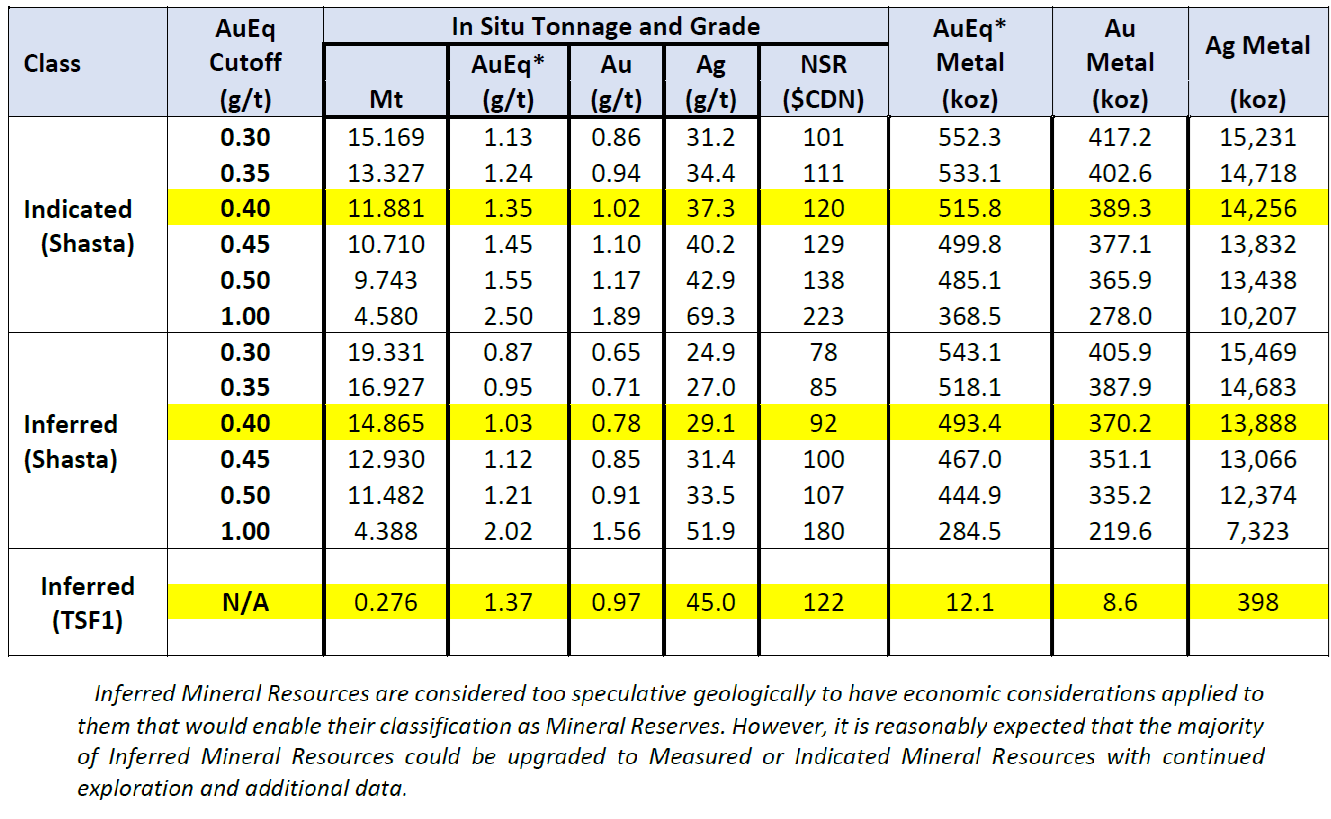

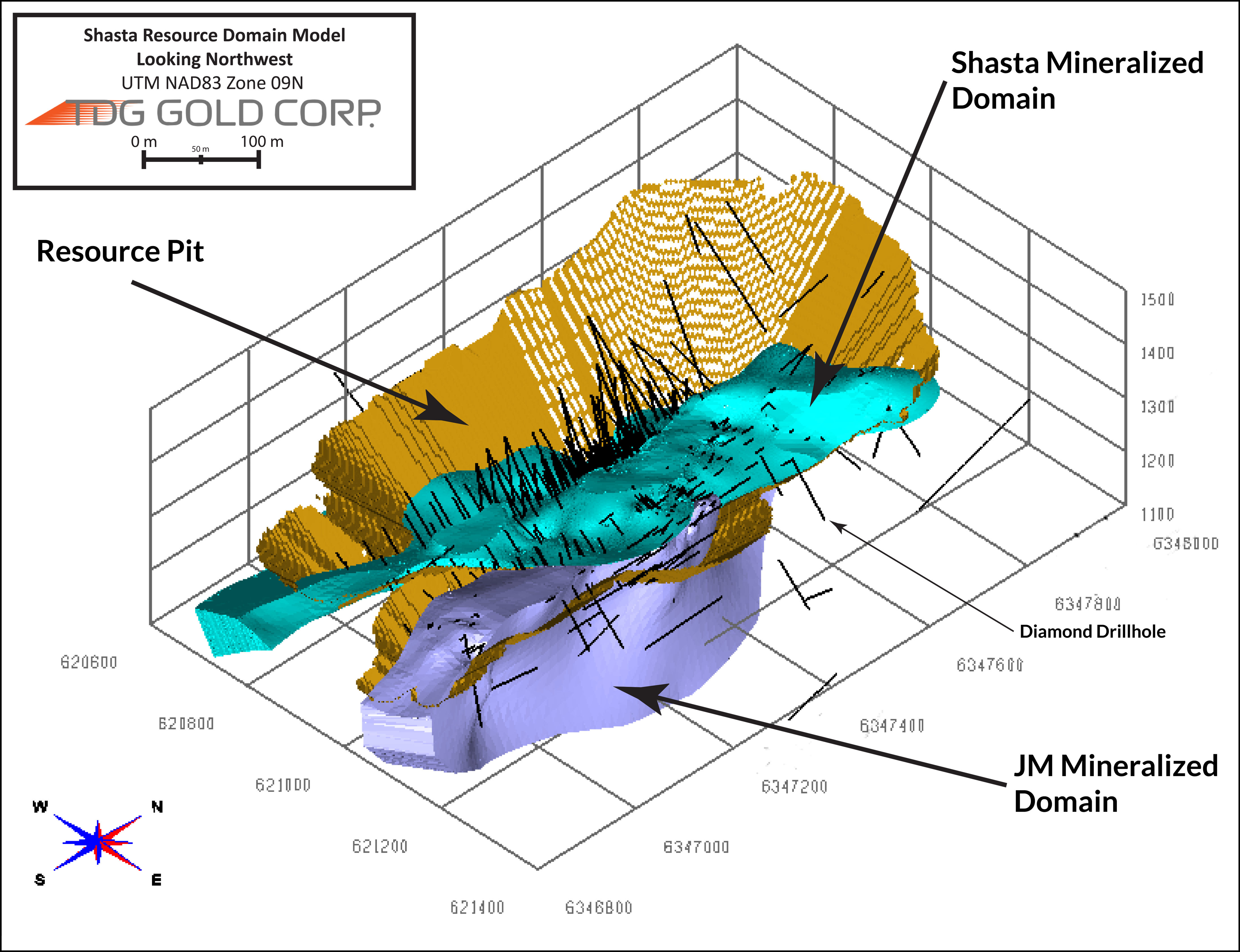
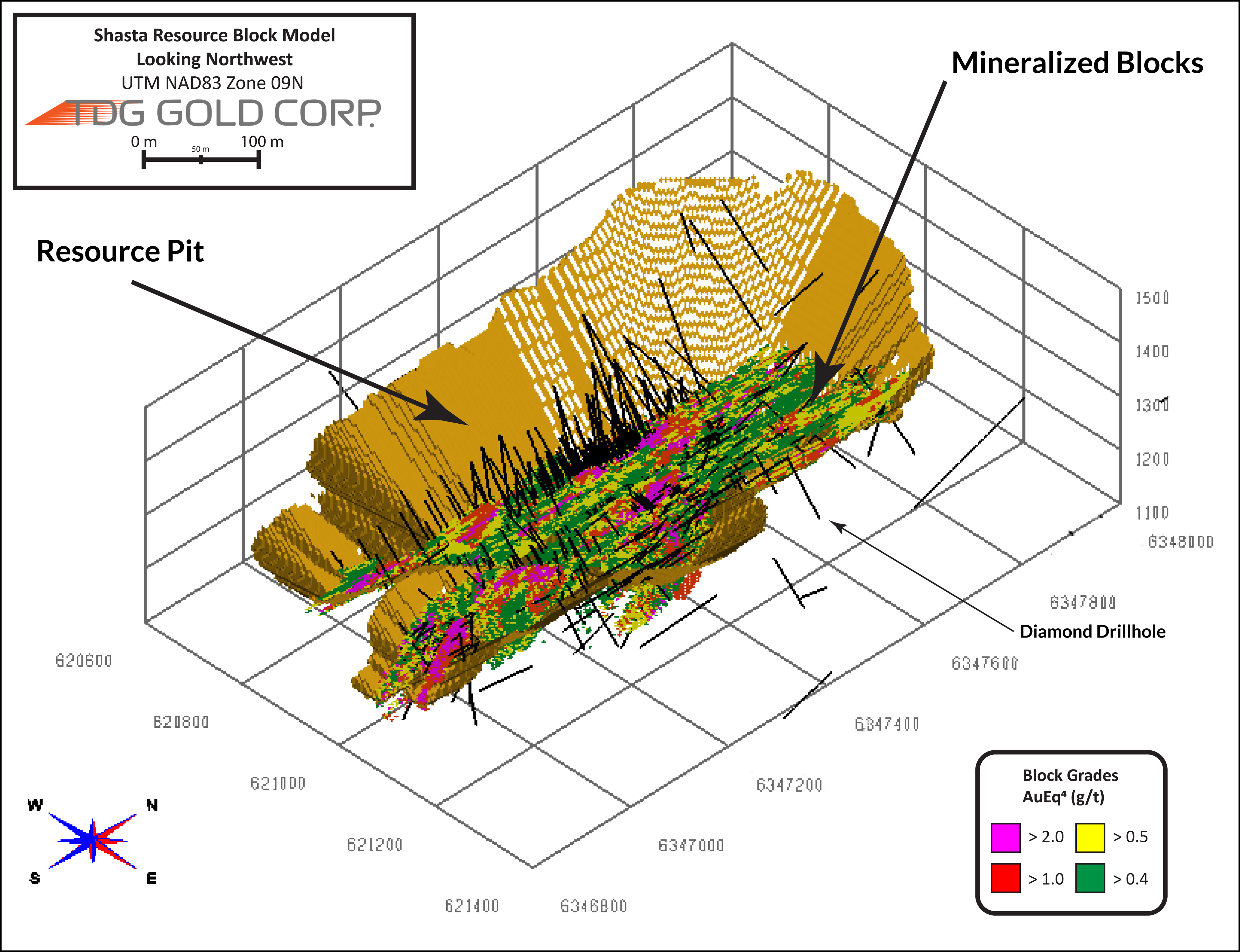
At a Glance
Shasta group of claims staked in 1972 by Shasta Mines and Oil Ltd. (later renamed Shasta Resources Ltd.)
Property is optioned by Asarco Ltd. but terminated due to poor results.
Newmont Exploration Canada Ltd. options the property and conducts surface exploration and 2,675 meters of drilling, discovering the Creek, Rainier and Jock Zones.
Esso Minerals Canada Ltd. option the property in 1987 and complete two years of exploration activities, discovering the JM and O Zones.
Homestake Mining Canada Ltd. purchase Esso and continue to delineate targets through 13,774 meters of step out drilling and 1,093 meters of confirmation and condemnation drilling.
In 1989, International Shasta Resources Ltd. and Sable Mining complete an agreement whereby Sable would mine 100,000 tonnes and process it at the Baker Mill.
Homestake drops its option, allowing Sable to acquire the Shasta Property from International Shasta.
An estimated 420,000 tonnes were mined by Sable on the JM and Creek Zones from 1989 to 1991, and between 2008 and 2012. Both Baker and Shasta Mines put under care and maintenance since 2012.
Talisker enters asset purchase agreement to acquire Sable Resources Ltd. Toodoggone properties, including both the Baker and Shasta mines and mill infrastructure as well as several exploration-level projects.
On December 11th 2020, TDG completes the acquisition of the Toodoggone asset portfolio from Talisker.
TDG completes two diamond drill campaigns aimed at validating the historical drilling and testing Shasta's bulk tonnage potential.
On May 17th, 2022, TDG published an Inferred initial NI 43-101 Mineral Resource Estimate for Shasta of 709,200 oz @ 1.00 g/t AuEq. Click here for more information.
On May 1st, 2023, TDG published an updated Mineral Resource Estimate for Shasta of showing improvements to grade, quantity and confidence. Click here for more information.
In January 2025, TDG published an updated MRE for Shasta incorporating historical drilling that TDG recovered and assayed in 2023. And an inaugural MRE for TSF1 that TDG drilled in 2024.
History
The Shasta group of claims were staked in 1972 by Shasta Mines and Oil Ltd., who later changed their name to International Shasta Resources Ltd. In 1978, the property was optioned by Asarco Ltd and option terminated due to poor results.
Newmont Exploration Canada Ltd. optioned the property in 1983. Through surface exploration and 2,675 m of diamond drilling discovered the Creek, Rainier and Jock zones.
Esso Minerals Canada Ltd. optioned the property in 1987 and over two years of exploration discovered the JM and O Zones.
Homestake Mining Canada Ltd. purchased Esso Minerals Canada Ltd. and continued ground exploration including 13,774 m of exploration diamond drilling and 1,093 m of delineation and condemnation diamond drilling.
In 1989 International Shasta Resources Ltd. and Sable completed a mining and assignment agreement whereby Sable would mine 100,000 tonnes and process it at the Baker mill. In 1990, Homestake dropped their option, and Sable acquired the Shasta property from International Shasta. An estimated total of 420,000 tonnes were mined by Sable on the JM and Creek zones from 1989 to 1991 and 2008 to 2012. The Shasta (and Baker Mines) have been under care and maintenance since 2012.
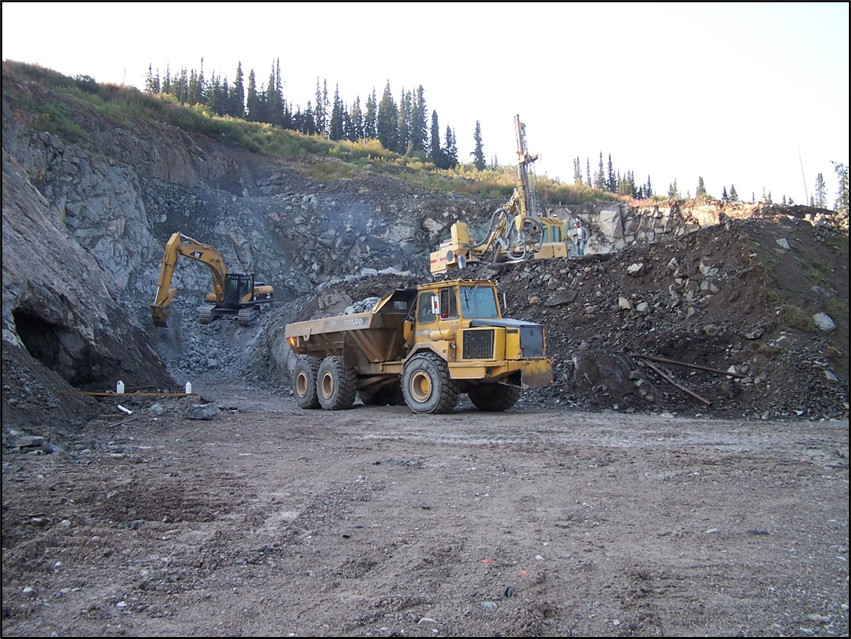
(Photo: Shasta Pit circa 2008)
On January 24, 2019, Talisker Resources entered into an asset purchase agreement to acquire Sable Resources Ltd.’s (“Sable”) mineral resource Toodoggone properties including the past producing Baker Gold/Silver Project; the Shasta Mine and Baker mill infrastructure and equipment; the Chappelle (Baker and Multinational Mines) Property; the Mets Lease and the Bot Property.
In total, twelve mineralized zones have been identified from the exploration and TDG’s data compilation has identified over 28,750m of historical drilling.
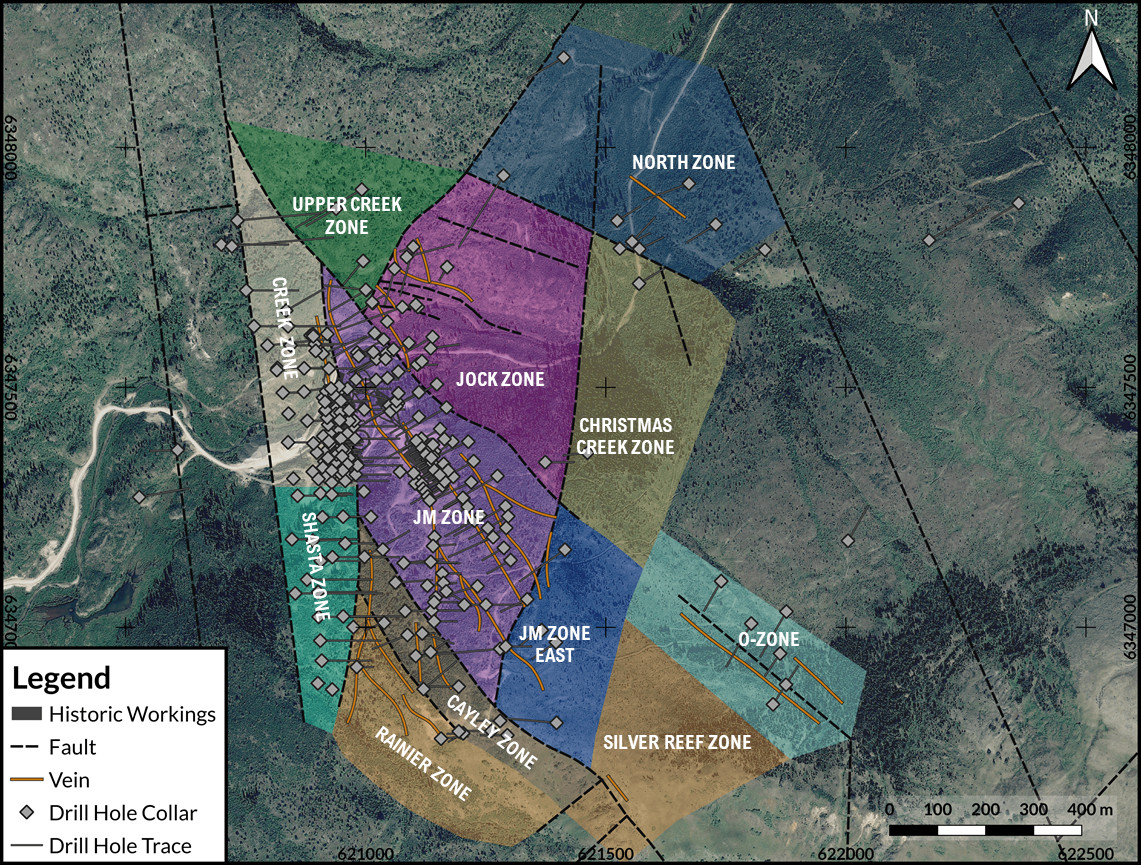
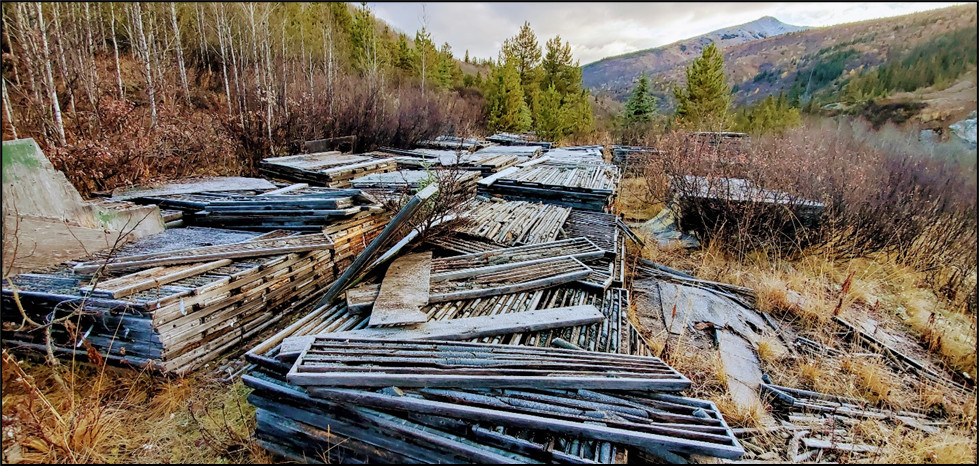
Photo: Shasta historical drill core
Stratigraphic Controls
The region is underlain by a thick succession of Jurassic Toodoggone Volcanic rocks, primarily tuffs and other fragmentary rocks formed through eruptions or active weathering of volcanic slopes. These units were defined by Marsden (1989) and each allocated a unit number, from 1 (oldest) to 24 (youngest).
At Shasta, the geology is dominated by Units 4 to 12, and the mineralization lies within Units 4 to 9. This implies that the epithermal system was active during or shortly after these rocks were deposited, and then ceased. This gives a temporal constraint to the mineralization on the site and allows for more effective targeting.
Exploration Upside
Historically, no mineralization was found in younger units and have been ignored. In the Upper Creek Zone, drill holes collared in Unit 12 and hit mineralization at depth where the drilling intercepted the “fertile” horizons. It is therefore possible that more Shasta-style mineralization will be found to the north and beneath a cap of younger unmineralized volcanic rocks.
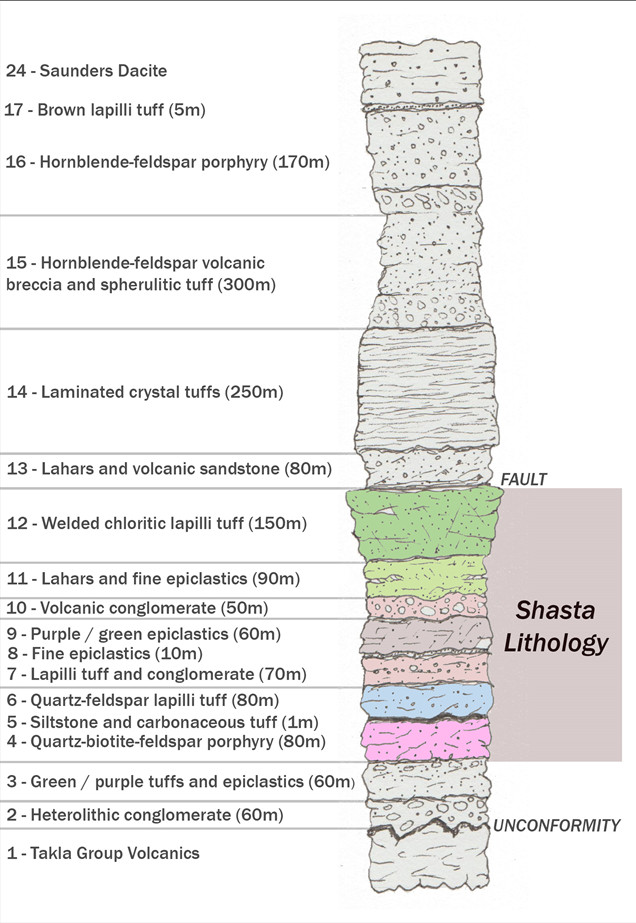
Above: Regional lithology (Upper Triassic Takla to Lower Jurassic Hazelton Groups) – modified from Marsden, 1989
Property Geology
The region occurs within the Intermontane Belt and is underlain by strata of the Stikine Terrane, which consists of Paleozoic to Mesozoic island arc assemblages and overlying Mesozoic sedimentary sequences (Smith, 2019).
A northwest-trending set of younger, steeply dipping faults and half-grabens are the principle structures found in the region. Major structural breaks are postulated to have been caused by, or be the result of, a northwest-trending line of volcanic centres (Diakow, Panteleyev, & Schroeter, 1993). Small stocks are also aligned northwesterly, suggesting they were also influenced by the same structural trend. Subsequent to volcanism and intrusion, younger faults are recognizable as northwest-trending lineaments (Smith, 2019).
At Shasta, structurally controlled mineralized zones also have northwest trends, and may similarly reflect syn- to immediately post-volcanic normal fault activity. Small stocks in the area are also aligned northwesterly, suggesting they were also influenced by the same structural trend. Subsequent to volcanism and intrusions, younger faults are recognizable as northwest-trending lineaments (Smith, 2019).
Alteration for the property consists of regional scale propylitic alteration of chlorite-epidote +/- calcite and pyrite. The lower grade regional alteration has been overprinted at Shasta by extensive potassic (quartz-adularia) alteration assemblage associated with a low-sulphidation epithermal system (Smith, 2019).
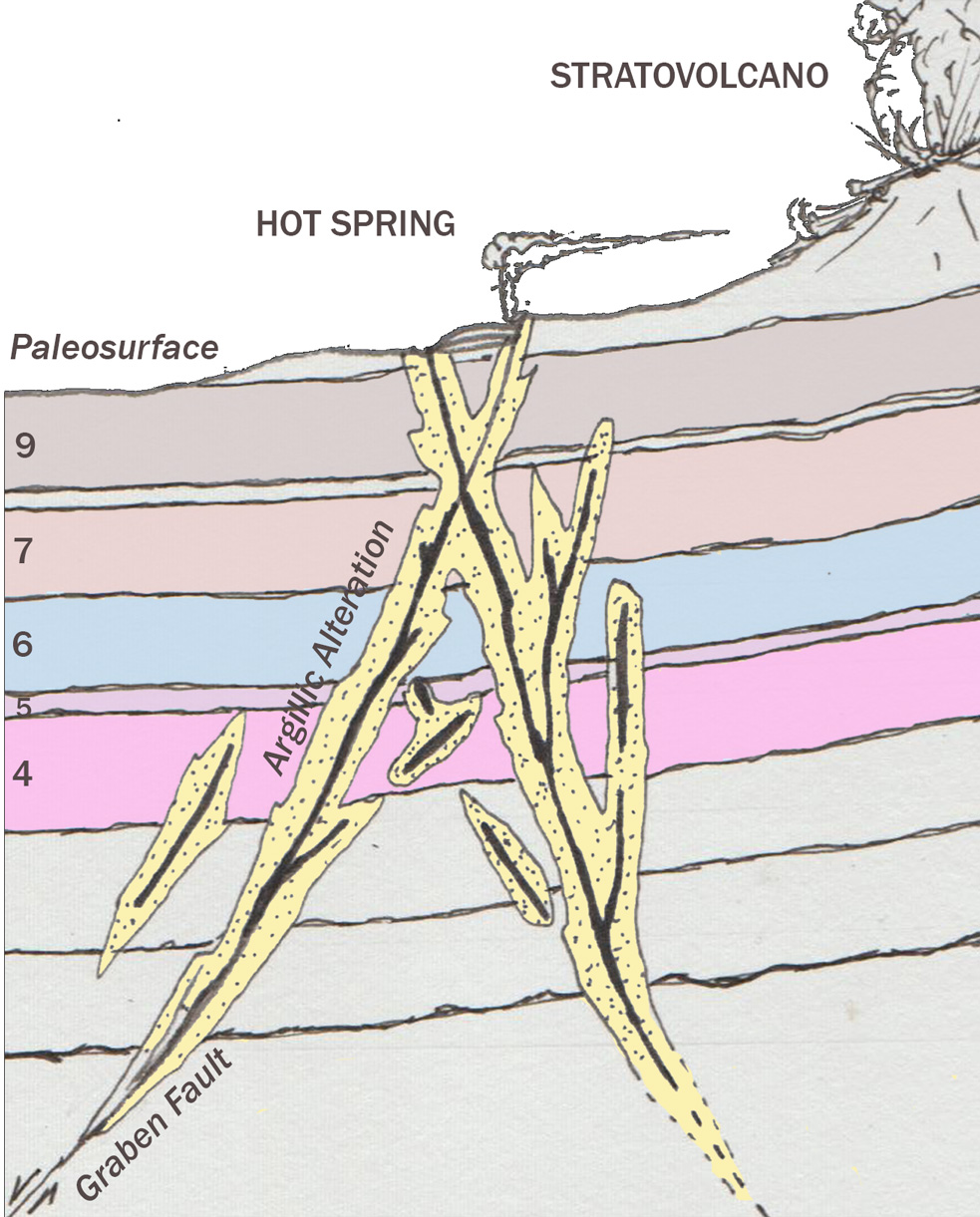
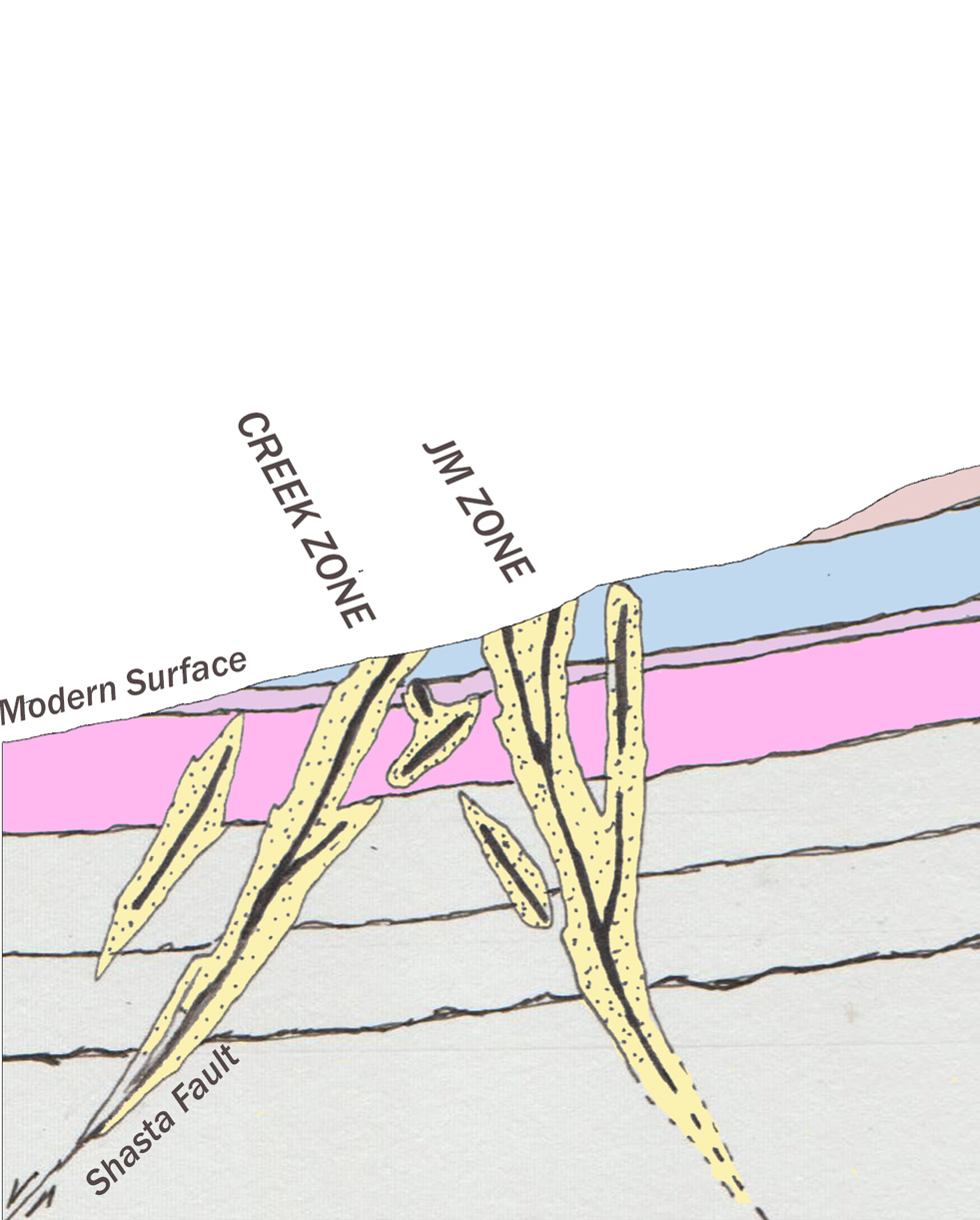
Geological Model
Early Jurassic: Active volcanism in the region creates hydrothermal systems that flow through faults along the edge of a basin. These become sites for gold and silver mineralization. The region continues to be buried under further volcanic and sedimentary materials.
Modern Day: Erosion removes overburden and exposes the host lithologies and vein system. The two major vein sets at Shasta form the Creek and JM Zones, with several smaller vein systems between such as the Cayley and Rainier Zones.
Drag the slider across the image to the left to demonstrate.
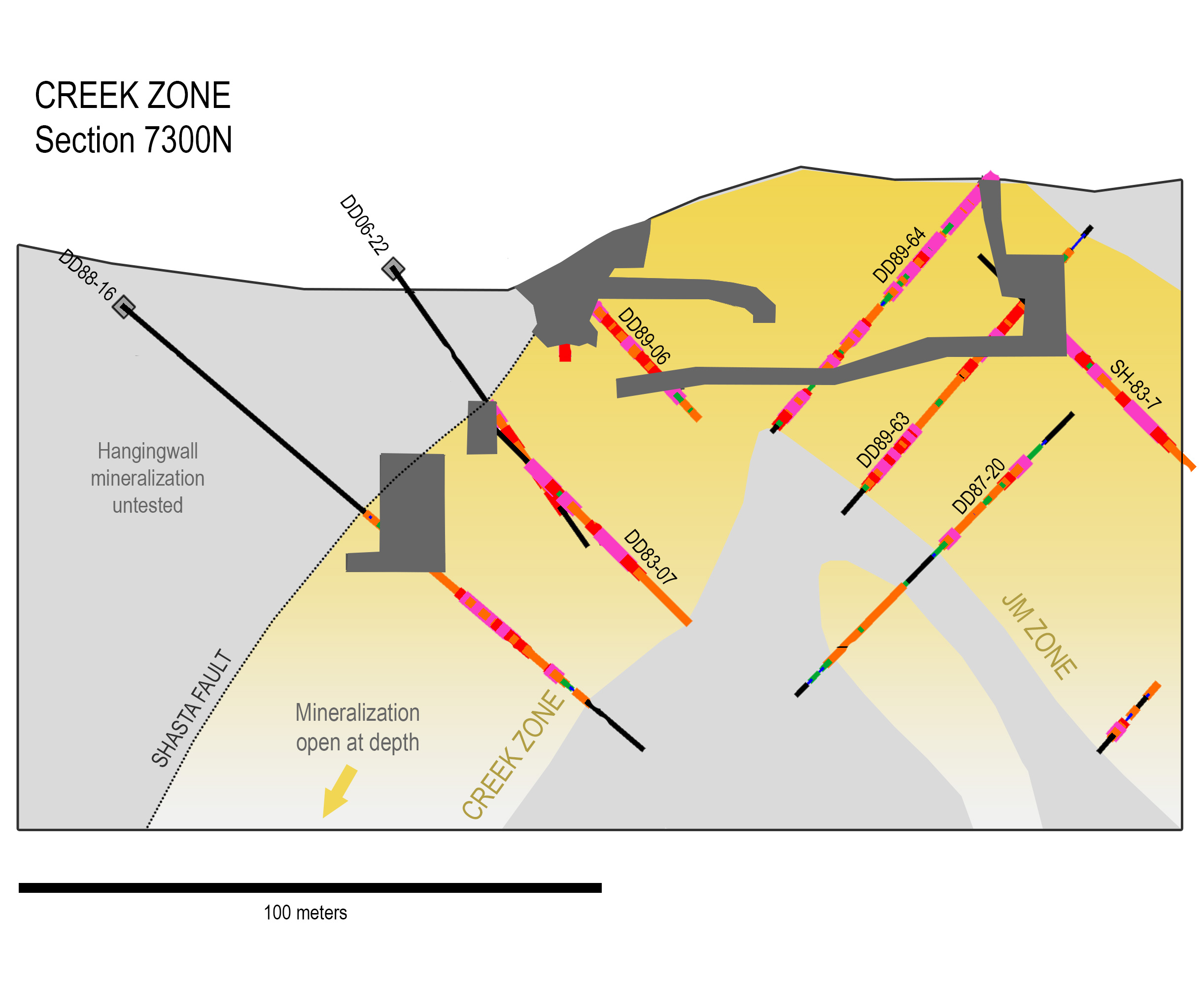
Modern Sections
The geometry and arrangement of these two vein systems is clearly seen in sections.
The veins and brecciation represent the higher grade core of the system, while a lower grade halo up to 60 meters wide exists around both the Shasta and JM Veins.
Mineralization
The Shasta deposit is an epithermal multiphase quartz-carbonate stockwork vein/breccia deposit containing significant silver and gold mineralization.
The Shasta deposit comprises a dozen tabular to curviplanar mineralized zones, of which the Creek and JM zones are the largest. The Creek zone strikes 180°, has a length of 875m and an average width of 5 to 10 m, and continues to a depth of ~300 m at a dip of 60° west; the JM zone strikes 330° over 1000 m and an average width of 5 to 10 m, and dips 70° east to plus 70 m depth. These attitudes produce an inverted “V” geometry that plunges shallowly to the northwest. Rocks hosting the deposit are probably equivalent to the Attycelley Member of the Toodoggone Formation, described by Diakow (1993) as green to mauve lapilli ash tuffs and lapilli-block tuffs with minor ash-flows, lava flows and epiclastic rocks (Marsden & Moore, 1990; Smith A., 2019).
In the mine area, the most prominent northerly trending structure is the Shasta fault, which strikes 180° and dips 50° west. This fault separates pyroclastic host rocks in the footwall from overlying epiclastic rocks in the hangingwall. The Shasta fault displays post mineralization movement, forming the hangingwall to the Creek zone near surface, but curving away from this zone at depth. In the JM zone, a late-stage carbonate vein (CB vein) forms the hangingwall to mineralization. The CB vein, which is essentially parallel to the JM zone, is semi-continuous over 200 m and varies from a 1.5 m wide vein to a 15 cm wide gouge filled seam. Given that both the CB vein and the Shasta fault are parallel to zones of mineralization and form the hangingwall of the mineralized zones, it is likely that these structures were the result of post-ore movement on faults that initially controlled permeability and focused hydrothermal fluids (Thiersch et al., 1997; Smith A., 2019).
Mineralized zones consist of cross-cutting, multi-stage quartz-calcite stockwork and breccia veins up to 30 m wide, enclosed by salmon-pink alteration envelopes up to 100 m wide. Individual stockwork veins are massive to crudely banded and 1 to 75 cm thick. Breccia veins pinch and swell along strike and down dip within the stockwork zones, forming discontinuous, subparallel or en-echelon pods up to 15 m wide, and consist of hydrothermally altered wallrock and vein fragments cemented by quartz and/or calcite. They range from narrow single-stage breccias of “jigsaw” type, to wider multi-stage breccias with repeatedly fractured and recemented fragments 1 to 100 cm in diameter.
Veins and breccia cement consist mainly of quartz and calcite. Quartz is dominant at higher levels and in the periphery of stockwork zones, and calcite is more abundant at lower levels and in the central part of the breccia zones. Quartz is characteristically fine-grained and locally chalcedonic, whereas calcite tends to be relatively coarse-grained. Veins commonly display multistage crack and fill textures, although open space-filling textures are also observed. Vugs are more common in calcite veins than in quartz veins. Minor chlorite and hematite, and rare late-stage barite are also present in veins. Multiple stage breccias are composed typically of silicified wallrock and quartz vein fragments cemented by quartz and calcite, or calcite alone. In order of decreasing abundance, sulfide and precious metal minerals consist of pyrite, sphalerite, galena, chalcopyrite, acanthite, native silver and electrum.
Reports
Below is a library of recent and historic reports for the project. Click on the link next on the last column to view (opens in a new window).
